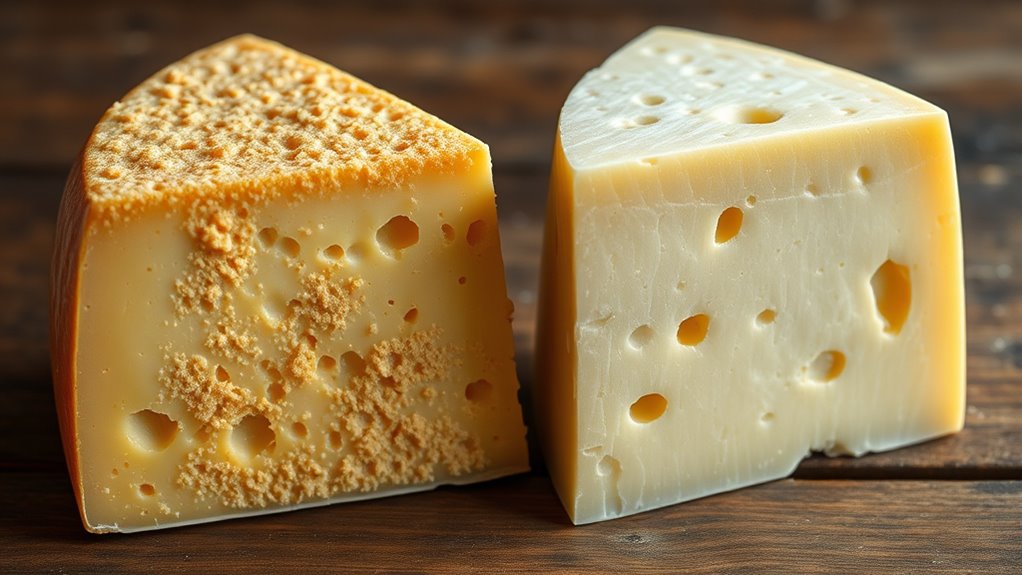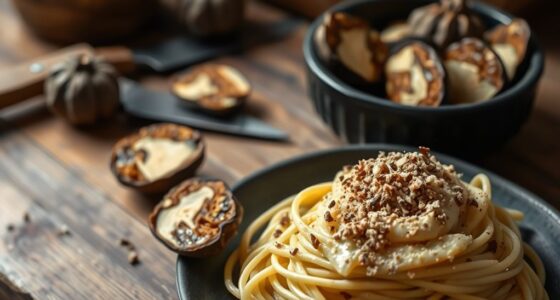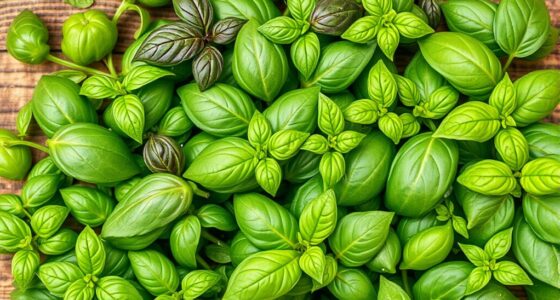If you compare Parmigiano Reggiano and Grana Padano, you’ll find that they come from different regions and are made with distinct methods. Parmigiano Reggiano is crafted in specific areas with strict traditional rules, aging longer for a richer, nuttier flavor. Grana Padano, meanwhile, is more widely produced, often with pasteurized milk and shorter aging. These differences give each cheese a unique taste, texture, and culinary use—discovering more will make their distinctions even clearer.
Key Takeaways
- Parmigiano Reggiano is produced exclusively in specific regions of Emilia-Romagna and Lombardy, ensuring strict regional authenticity.
- It is aged for at least 12 months, often over 24, developing a richer, nutty flavor and granular texture, unlike the milder Grana Padano.
- Parmigiano Reggiano uses only raw, unpasteurized milk, while Grana Padano allows pasteurized milk and broader regional practices.
- Its higher production standards and regional controls typically result in a higher market price and stricter quality assurance.
- Parmigiano Reggiano has a more complex flavor profile suited for bold uses, whereas Grana Padano offers a milder taste for versatile culinary applications.
Geographic Origins and Production Regions
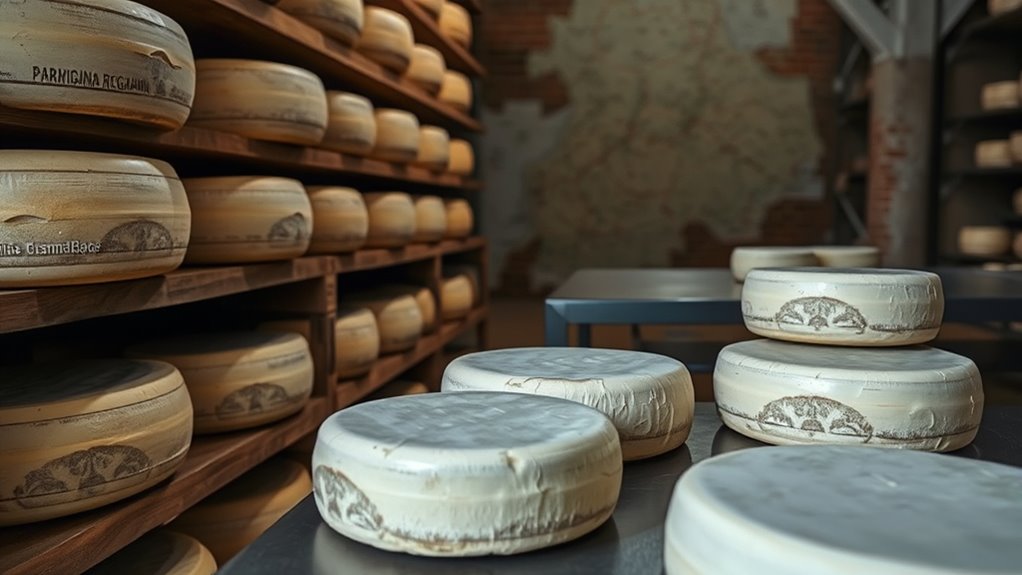
While Parmigiano Reggiano and Grana Padano share similarities, their geographic origins are distinct. Parmigiano Reggiano’s production is confined within specific geographical boundaries in Emilia-Romagna and parts of Lombardy, ensuring strict regional control. This limited area cultivates a unique regional terroir, influenced by local climate, soil, and traditional practices. In contrast, Grana Padano’s production spans a broader region across northern Italy, including Lombardy, Veneto, and Trentino. Its wider geographical boundaries contribute to a more diverse regional terroir, producing a cheese with slightly different characteristics. These differences in geographic boundaries shape the cheese’s flavor profile, texture, and identity, emphasizing the importance of regional terroir in defining each cheese’s unique qualities. regional terroir also affects the aging process and the subtle nuances that distinguish these two beloved cheeses. Additionally, the geographical indications assigned to each cheese help protect their authenticity and traditional production methods, further emphasizing their regional origins. The specific production regulations for each cheese ensure adherence to traditional methods, preserving their distinctive qualities. Furthermore, regional regulations are strictly enforced to maintain quality standards across different production areas. The influence of local climate conditions also plays a critical role in the cheese’s development and final characteristics.
Traditional Production Methods and Regulations

The traditional production methods and regulations for Parmigiano Reggiano and Grana Padano are strict, ensuring each cheese maintains its distinctive qualities. Artisan traditions play a crucial role, with specific techniques passed down through generations. For Parmigiano Reggiano, regulations specify the use of only raw, local cow’s milk from the production region, along with a specific curdling process and natural rennet. Grana Padano, while similar, allows more flexibility, including the use of pasteurized milk and different regional practices. Regional differences influence these methods, affecting texture and flavor. These regulations preserve the unique identities of each cheese and uphold the authenticity that consumers expect. Strict adherence guarantees that both cheeses meet high standards rooted in regional customs and artisan craftsmanship. Moreover, embracing traditional creative practices ensures the preservation of regional culinary heritage and fosters innovation within established standards.
Additionally, the geographical indication status helps protect the authenticity of each cheese and supports local producers in maintaining quality standards.
Aging Processes and Flavor Profiles
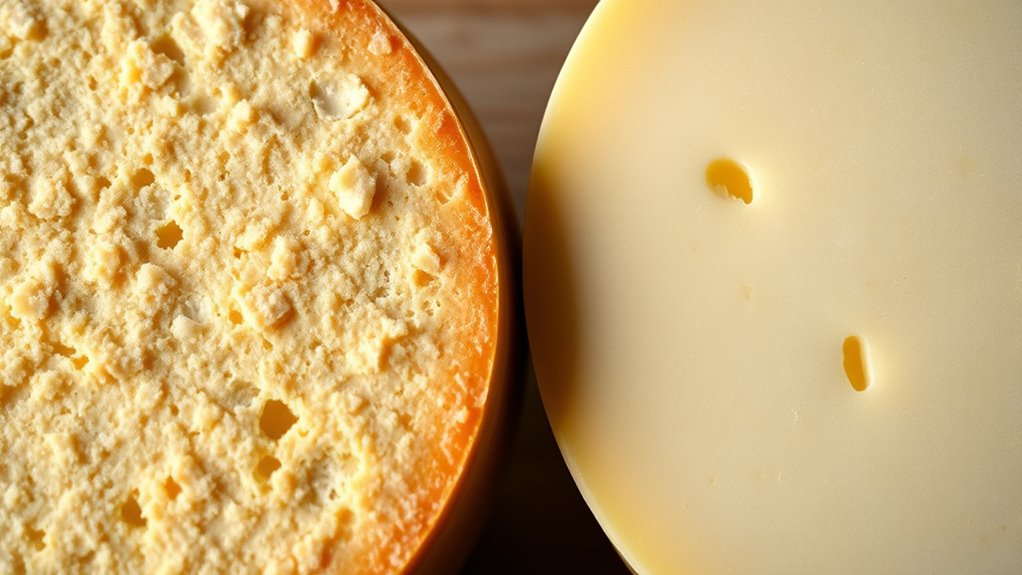
Aging is a crucial factor that shapes the distinct flavor profiles of Parmigiano Reggiano and Grana Padano. Parmigiano Reggiano typically ages for at least 12 months, often reaching 24 or more, which develops its rich, complex flavors. In contrast, Grana Padano generally ages for a shorter period, around 9 to 16 months, resulting in a milder taste. The longer aging duration of Parmigiano Reggiano allows it to develop deeper flavor complexity, with nutty, caramel notes and a granular texture. Grana Padano’s shorter aging process produces a more delicate, less intense flavor. These aging differences influence how each cheese’s flavor evolves, giving Parmigiano Reggiano its signature depth and Grana Padano its lighter, more accessible profile.
Texture and Appearance Differences
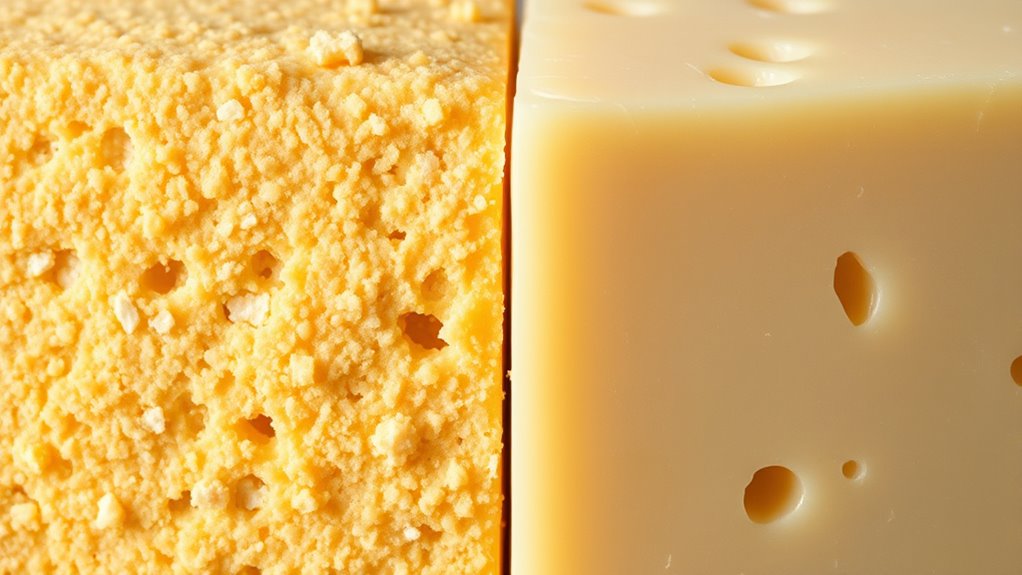
The aging process directly impacts the textures and appearances of Parmigiano Reggiano and Grana Padano. You’ll notice texture variations: Parmigiano Reggiano tends to be grainier and crumblier, while Grana Padano is slightly softer and more elastic. Appearance distinctions also stand out; Parmigiano Reggiano has a rugged, mottled rind and granular interior, whereas Grana Padano features a smoother, firmer surface with a more uniform crumb. These differences result from their distinct aging durations and production techniques. Proper cheese aging is essential in developing these unique characteristics. Here’s a quick comparison:
| Feature | Parmigiano Reggiano | Grana Padano |
|---|---|---|
| Texture Variations | Grainy, crumbly, granular | Softer, elastic, slightly moist |
| Appearance | Mottled rind, granular interior | Smooth rind, uniform crumb |
| Rind | Thick, rugged | Thinner, smoother |
| Crumb | Fragile, easily breaks apart | Firm, cohesive |
| Aging Duration | Longer, 12-36 months | Shorter, 9-24 months |
Milk Sources and Composition
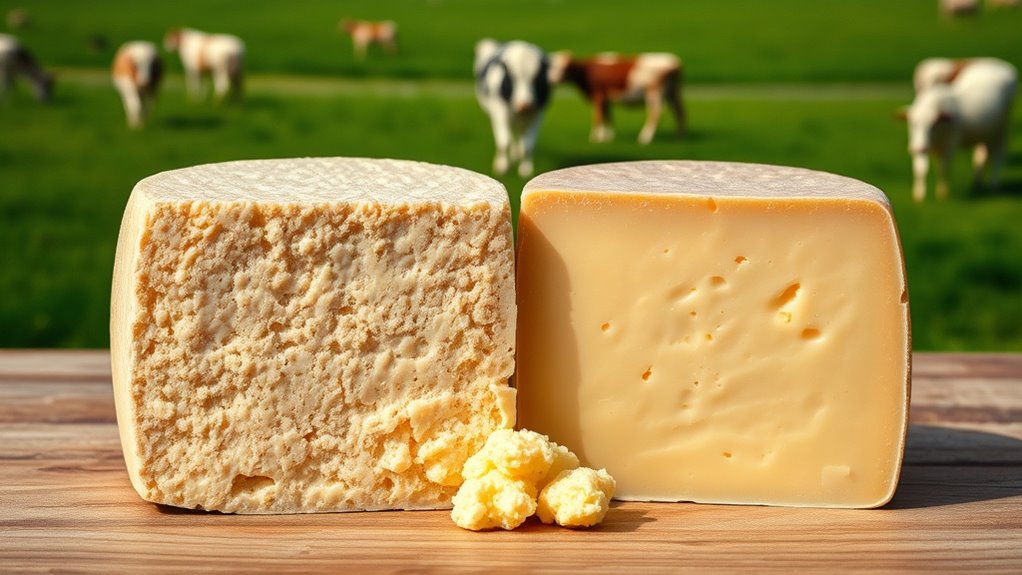
Understanding the milk sources for Parmigiano Reggiano and Grana Padano is essential because their unique compositions influence flavor and texture. The milk origin differs: Parmigiano Reggiano uses only raw, local cow’s milk from specific regions, while Grana Padano can include milk from broader areas and may involve a mix of raw and pasteurized milk. These compositional differences directly impact the cheese’s final characteristics. Additionally, the milk composition—including factors like fat and protein content—plays a crucial role in shaping the cheese’s texture and aging potential. Variations in milk processing methods also contribute to the distinct identities of each cheese.
Pricing and Market Availability

Pricing and market availability for Parmigiano Reggiano and Grana Padano differ markedly due to their production methods and regional controls. Parmigiano Reggiano’s strict regulations and limited production areas tend to keep its market price trends higher and more stable. In contrast, Grana Padano’s broader regional accessibility allows for more flexible pricing, often making it more affordable and widely available. Additionally, regulatory compliance plays a significant role in maintaining the distinct market dynamics of each cheese. The differences in geographical origin further influence consumer perception and market value. Moreover, market demand can fluctuate based on consumer preferences and global economic conditions, impacting their respective prices. The production techniques employed also contribute to their unique market positioning and pricing structures. Keeping these factors in mind, the overall market stability of Parmigiano Reggiano is often attributed to its regulatory protections, which help preserve its premium status.
Culinary Uses and Pairing Options
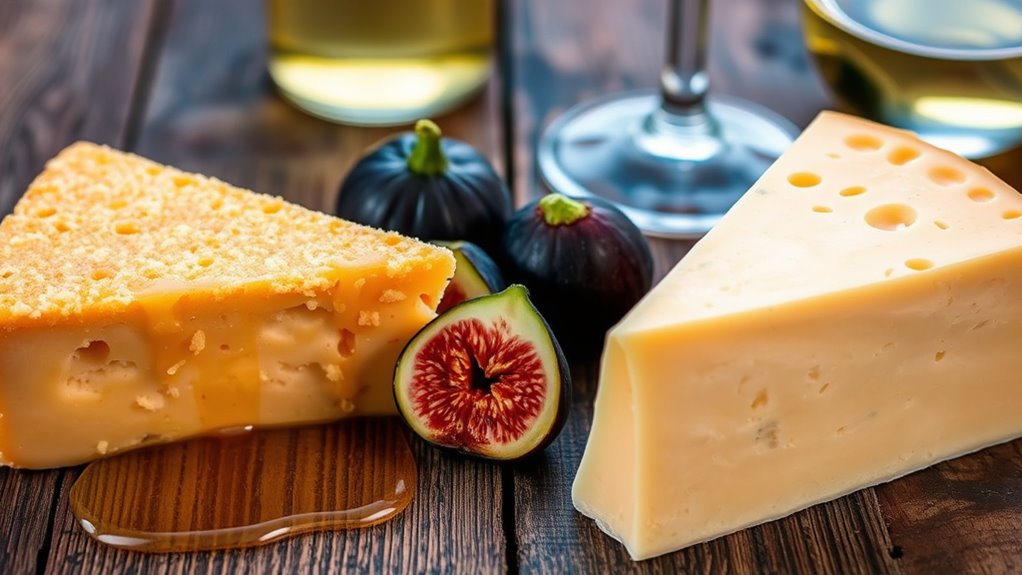
Parmigiano Reggiano and Grana Padano both bring distinct flavors and textures that lend themselves well to a variety of culinary uses. You’ll find that their excellent cheese melting qualities make them ideal for risottos, pasta, and gratins. Their cooking versatility allows you to enhance dishes with rich umami flavor or add sharpness as a finishing touch.
- Use Parmigiano Reggiano for bold, complex toppings or grated over salads to highlight its depth.
- Incorporate Grana Padano into sauces or soups for a milder, creamy melt.
- Experiment with both cheeses in cheese boards, pairing them with fruits and nuts to balance their distinct profiles.
These cheeses elevate your dishes with their distinct characteristics and melting abilities, making them staples in your kitchen.
Certifications and Quality Standards

Both Parmigiano Reggiano and Grana Padano are protected by strict certifications that guarantee their authenticity and quality. These standards regulate dairy farming practices, ensuring the milk comes from specific regions and meets high safety criteria. Parmigiano Reggiano’s certification requires traditional production methods, including aging for at least 12 months, and adherence to specific geographic boundaries. Grana Padano also follows rigorous standards, with a slightly shorter aging process. Both cheeses comply with export regulations that help maintain their reputation worldwide. These certifications prevent counterfeiting and ensure consistency, giving you confidence in their quality. By meeting these strict standards, producers uphold the traditional methods that make each cheese unique and authentic in the global market.
Frequently Asked Questions
How Do the Nutritional Contents of Parmigiano Reggiano and Grana Padano Compare?
When comparing the nutritional contents of Parmigiano Reggiano and Grana Padano, you’ll notice both are rich in protein, calcium, and flavor. However, Parmigiano Reggiano generally has a higher concentration of nutrients and less moisture, making it more nutrient-dense. This nutritional comparison highlights the health benefits of both cheeses, such as supporting bone health and providing essential vitamins. You’ll find that choosing Parmigiano Reggiano can offer slightly more nutritional value for your diet.
Are There Any Notable Cultural or Historical Differences Influencing Their Production?
Imagine tasting cheese that carries centuries of cultural heritage. You’d notice that Parmigiano Reggiano’s production relies on traditional methods passed down through generations, rooted in specific regional practices. In contrast, Grana Padano’s history reflects a broader, less restrictive tradition. These cultural and historical differences shape their unique flavors, textures, and production standards, making each cheese a reflection of its region’s rich heritage and long-standing artisanal techniques.
Which Cheese Is More Environmentally Sustainable to Produce?
You probably wonder which cheese is more eco-friendly. Parmigiano Reggiano often emphasizes sustainable farming and eco-friendly practices, reducing environmental impact with strict regulations on production and aging. Grana Padano also adopts sustainable methods but tends to have a slightly larger production scale, potentially affecting its sustainability. Overall, Parmigiano Reggiano’s focus on traditional, sustainable farming methods makes it the more environmentally conscious choice.
How Do Their Aging Processes Impact Health Benefits?
You might think aging’s just about flavor, but it actually impacts health benefits too. With longer aging, Parmigiano Reggiano develops a richer profile, boosting digestive benefits by breaking down more proteins and carbs. Grana Padano, aging less, offers slightly fewer benefits. So, if you’re after maximum digestive health perks, longer aging makes all the difference, turning cheese into a more beneficial snack—who knew?
Can They Be Substituted for Each Other in Recipes?
You can substitute Parmigiano Reggiano and Grana Padano in recipes, but keep in mind their flavor profiles differ. Parmigiano Reggiano offers a richer, nuttier taste, enhancing dishes with depth, while Grana Padano has a milder, slightly sweeter flavor. Both cheeses provide culinary versatility, working well in pasta, salads, or risottos. Choose based on your desired flavor impact, but note that substitutions may alter the final taste.
Conclusion
Now that you know the key differences between Parmigiano Reggiano and Grana Padano, you see they each have their own unique charm. Whether you prefer the rich, complex flavors or the more affordable, versatile option, it’s clear you shouldn’t judge a cheese by its rind alone. Ultimately, choosing between them is like picking your favorite song; it all depends on your personal taste. So go ahead—try both and decide which hits the right note for you.
